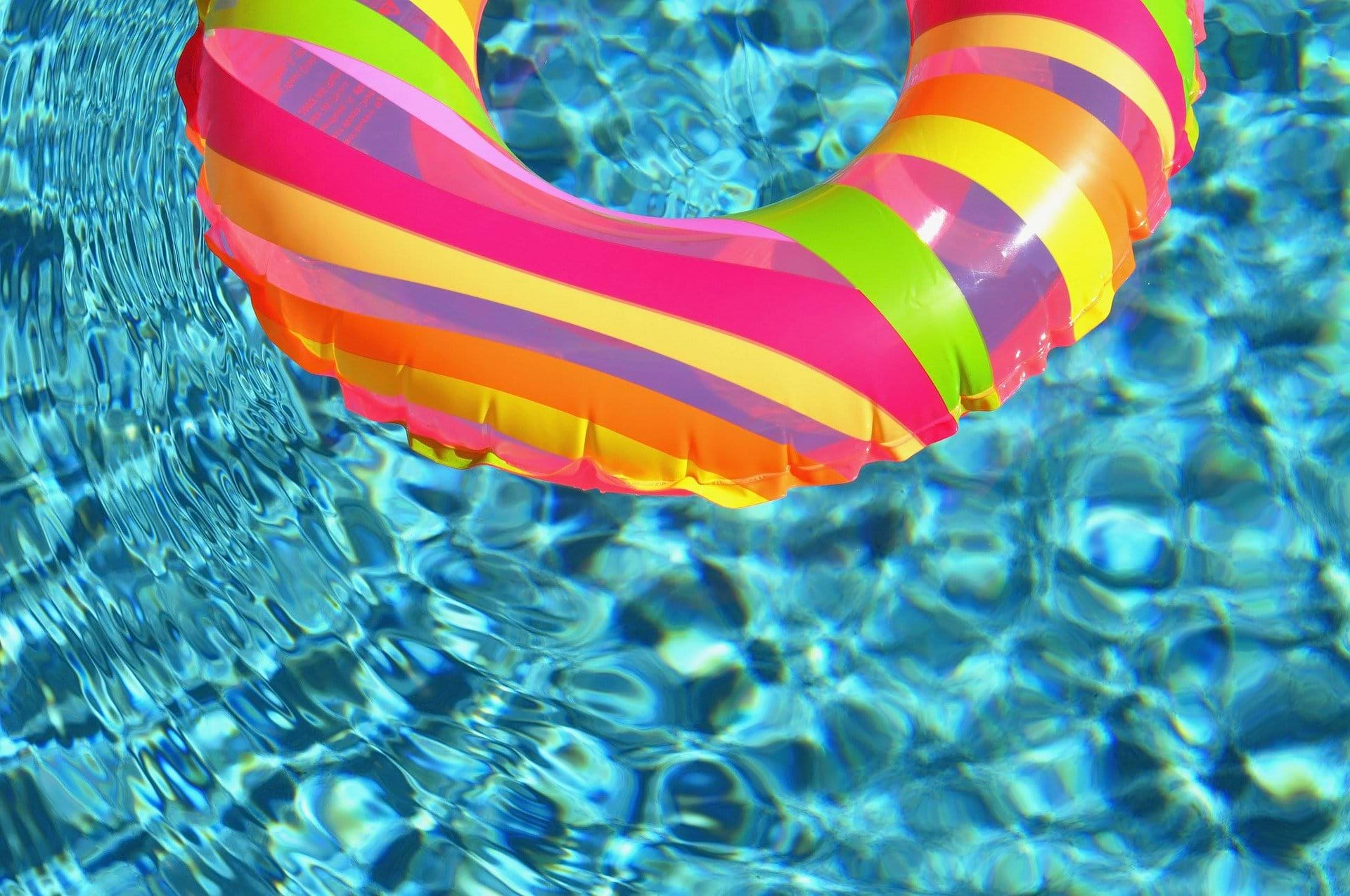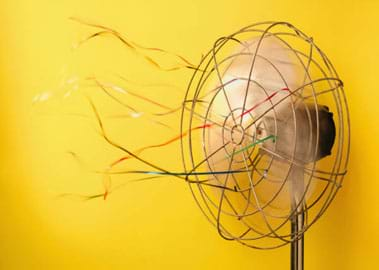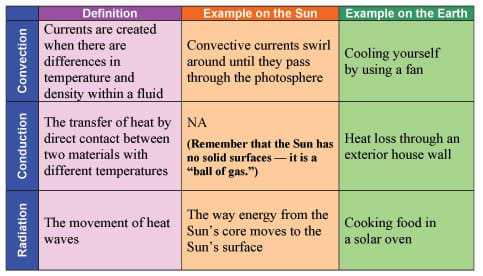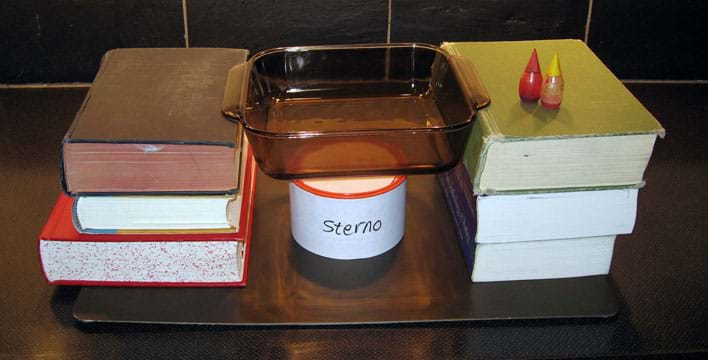Quick Look
Grade Level: 4 (3-5)
Time Required: 30 minutes
Expendable Cost/Group: US $5.00
Group Size: 28
Activity Dependency: None
Subject Areas: Earth and Space
NGSS Performance Expectations:

| 4-PS3-2 |
Summary
Through a teacher demonstration using water, heat and food coloring, students see how convection moves the energy of the Sun from its core outwards. Students learn about the three different modes of heat transfer—convection, conduction, radiation—and how they are related to the Sun and life on our planet. Includes a student worksheet for data collection and graphing.
Engineering Connection
Engineers design measuring devices to record changes in density and temperature on the Sun. By observing the Sun we can learn about what is happening under the surface and how heat is moving through the Sun. Heat transfer also occurs on Earth and engineers need to understand the different modes in order to build devices and structures that do not overheat or get too cold.
Learning Objectives
After this activity, students should be able to:
- Define the three different modes of heat transfer.
- Explain how heat gets from the Sun to Earth.
- Give one example of why engineers need to understand heat transfer.
Educational Standards
Each TeachEngineering lesson or activity is correlated to one or more K-12 science,
technology, engineering or math (STEM) educational standards.
All 100,000+ K-12 STEM standards covered in TeachEngineering are collected, maintained and packaged by the Achievement Standards Network (ASN),
a project of D2L (www.achievementstandards.org).
In the ASN, standards are hierarchically structured: first by source; e.g., by state; within source by type; e.g., science or mathematics;
within type by subtype, then by grade, etc.
Each TeachEngineering lesson or activity is correlated to one or more K-12 science, technology, engineering or math (STEM) educational standards.
All 100,000+ K-12 STEM standards covered in TeachEngineering are collected, maintained and packaged by the Achievement Standards Network (ASN), a project of D2L (www.achievementstandards.org).
In the ASN, standards are hierarchically structured: first by source; e.g., by state; within source by type; e.g., science or mathematics; within type by subtype, then by grade, etc.
NGSS: Next Generation Science Standards - Science
| NGSS Performance Expectation | ||
|---|---|---|
|
4-PS3-2. Make observations to provide evidence that energy can be transferred from place to place by sound, light, heat, and electric currents. (Grade 4) Do you agree with this alignment? |
||
| Click to view other curriculum aligned to this Performance Expectation | ||
| This activity focuses on the following Three Dimensional Learning aspects of NGSS: | ||
| Science & Engineering Practices | Disciplinary Core Ideas | Crosscutting Concepts |
| Make observations to produce data to serve as the basis for evidence for an explanation of a phenomenon or test a design solution. Alignment agreement: Analyze and interpret data to make sense of phenomena using logical reasoning.Alignment agreement: | Energy can be moved from place to place by moving objects or through sound, light, or electric currents. Alignment agreement: Energy is present whenever there are moving objects, sound, light, or heat. When objects collide, energy can be transferred from one object to another, thereby changing their motion. In such collisions, some energy is typically also transferred to the surrounding air; as a result, the air gets heated and sound is produced.Alignment agreement: Light also transfers energy from place to place.Alignment agreement: | Energy can be transferred in various ways and between objects. Alignment agreement: |
Common Core State Standards - Math
-
Draw a scaled picture graph and a scaled bar graph to represent a data set with several categories. Solve one- and two-step "how many more" and "how many less" problems using information presented in scaled bar graphs.
(Grade
3)
More Details
Do you agree with this alignment?
-
Represent and interpret data.
(Grade
4)
More Details
Do you agree with this alignment?
International Technology and Engineering Educators Association - Technology
-
Energy comes in different forms.
(Grades
3 -
5)
More Details
Do you agree with this alignment?
-
Tools, machines, products, and systems use energy in order to do work.
(Grades
3 -
5)
More Details
Do you agree with this alignment?
State Standards
Colorado - Math
-
Draw a scaled picture graph and a scaled bar graph to represent a data set with several categories.
(Grade
3)
More Details
Do you agree with this alignment?
-
Visual displays are used to interpret data.
(Grade
5)
More Details
Do you agree with this alignment?
Colorado - Science
-
Identify and describe the variety of energy sources
(Grade
4)
More Details
Do you agree with this alignment?
-
Energy comes in many forms such as light, heat, sound, magnetic, chemical, and electrical
(Grade
4)
More Details
Do you agree with this alignment?
Materials List
To share with the entire class (teacher demonstration):
- clear baking dish (ideal: 8x8 inch [20x20 cm] PyrexTM baking dish)
- 6 or more dictionaries or thick text books
- portable heat source, such as a small burner, can of SternoTM, propane or small warming candle in a fireproof holder
- fireproof surface
- water
- food coloring (orange works well)
- glitter
- digital thermometer
- Heat Transfer Worksheet, one per person
Worksheets and Attachments
Visit [www.teachengineering.org/activities/view/cub_solar_lesson02_activity1] to print or download.Pre-Req Knowledge
Familiarity with the Sun's composition, layers and importance as Earth's energy source, as provided in the Blazing Gas lesson of this Solar System unit.
Introduction/Motivation
Can heat move? Of course it can. Heat (energy) travels in three ways: convention, conduction and radiation. Conduction works by direct contact of two materials. This is what happens when a pot is placed on the stove. First the stove material is heated. Then the heat is transferred by conduction to the pot, which is in direct contact with the hot stove. Convection works through the interaction of fluid molecules such as air or water. Convection typically occurs when a hot fluid or gas moves upward. Radiation works through the movement of heat waves. This is similar to light and radio waves.
So, how does heat get from the Sun to Earth? Conduction and convection require a material (either solid, liquid or gas) to be present. (Emphasize: Since there is no matter in space between the Sun and Earth, all the heat from the Sun comes to us in the form of radiation.) Inside the Sun is matter and therefore other forms of heat transfer are at work. The Sun uses two methods to transport energy out from the interior. The first is radiation. Radiation begins in the Sun's core. In the Sun's radiation zone, heat from the core travels as electromagnetic waves (radiation) outwards to the Sun's convective zone. Convection currents are currents created when there are differences in temperature and density. (Emphasize: Warmer liquids and gasses are less dense and therefore float (or rise) when in cooler liquids and gasses.) ) As this warmer gas (or liquid) rises, cooler gas (or liquid) moves to take its place where it is heated. This is called a convection current. Convection currents swirl the energy until it passes through to the Sun's photosphere.

When the Sun's energy (in the form of radiation) hits our planet's atmosphere, some of it reflects off while some of it heats up the air, water and land. Once the material that makes up the Earth and its atmosphere is heated, it can move around the globe through convection and conduction. Heat loss through a wall is an example of conduction. Insulation limits conduction and keeps the heat inside your house. Cooling yourself with a fan is an example of convection. Convection is the reason it feels colder on a windy day.
Engineers must understand how heat moves so that the devices they build do not get too hot or too cold. What would happen if an engineer did not make sure there was insulation in the walls of your house? It would be very cold inside on a winter day because the heat could escape through conduction. What would happen if the cord to an appliance did not have an insulated covering on it? The wire would be exposed and the electricity running through it could hurt someone or start a fire. What would happen if an engineer wrapped an engine in insulation? The heat generated by the engine would not be able to get out and the engine would overheat.

Table 1 provides examples of convection, conduction and radiation on the Sun and on Earth. It may be helpful to draw the table on the board as a way to graphically organize and distinguish the concepts.
Procedure
Before the Activity
- Gather materials for the teacher demonstration.
- Make copies of the Heat Transfer Worksheet.
With the Students
- Explain to students the three different modes of heat transfer (radiation, conduction and convection). Refer to examples in Table 1.
- Have students write their heat transfer definitions on the worksheet, with an example of each that they have experienced or seen in their own lives.
- Tell students that they will be recording observations and data on their worksheets to use in making a bar graph at the end of the demonstration.
- Make sure all students can see the demonstration and that, for safety, no student is too close to the flame.
- Place the baking dish on two piles of dictionaries that are high enough and far enough apart to place a fireproof plate and sternoTM can (or warming candle) under the baking dish (see Figure 1).

- Pour cool water into the baking dish.
- Make sure the table is very still so that the water does not move. Take the temperature of the water in Celsius or Fahrenheit. Have students record the temperature. Repeat the temperature several times so all students have time to record the temperature on their worksheets (a volunteer may want to keep track on the board).
- Carefully light the heat source. Drop a few drops of food coloring and some glitter into the water. It works best to drop the glitter and food coloring into the water directly above the heat source.
- Take the temperature of the water in Celsius or Fahrenheit at two-minute intervals. Be sure to take the temperature in roughly the same location in the dish every time. What is happening to the glitter as the water gets hotter? Have students record the temperatures.
- The heat source should slowly heat the water in the middle of the baking dish. The food coloring helps students observe the movement of the water.
- The glitter flows from the high heat in the center to the outsides where it is cooler. Convection transfers heat (energy) by currents of gas or liquid. (It may help to have students get up and walk past the demonstration so that they can get a closer look.)
- Have students record their observations on the worksheet.
- Explain to students that their evaluation will be graded on how thoroughly and accurately they record the demonstration.
- Have students make a bar graph of the temperature. What do they notice about the temperature? (The water temperature should show an increase.)
- Conclude by reviewing the learning objectives. Clarify any questions and conduct the post-activity assessment in the Assessment section. Review the ways that heat moves.
- Conduction = by direct contact of two materials
- Convection = by the interaction of fluid molecules (such as air or water)
- Radiation = by the movement of heat waves.
Vocabulary/Definitions
conduction: The transfer of heat from a region of higher temperature to a region of lower temperature by increased kinetic energy moving from molecule to molecule.
convection: Transfer of heat in a fluid (liquid or gas) when higher-temperature fluid expands and moves, creating heat transfer.
density: The compactness of matter described by a ratio of mass (or weight) per unit volume.
radiation: The transfer of heat from a region of higher temperature to a region of lower temperature by greater emission of radiant energy from the region of higher temperature.
Assessment
Pre-Activity Assessment
Discussion Questions: Ask students what they know about heat movement. Can heat move? If it can, how does it move? Introduce the concepts of conduction, convection and radiation. How many things in your kitchen are designed to take advantage or protect you from the three ways of heat transfer? When do they see these kinds of heat transfer in their daily lives? Real-life examples: Sunburn is radiation from the Sun moving 93 million miles (150 million km) through space to heat your skin. The outside of a mug of hot cocoa is warm because the heat in the liquid is moving to the outside of the mug through conduction. The fact that the water on the surface of a swimming pool is warmer than the water in the deep parts is caused by convection.
Activity Embedded Assessment
Voting: Before starting the class demonstration, ask the students to vote on the following question. Tally votes on the board. Tell the students that the question will be answered during the demonstration.
- When you heat a container of water, does the water move or stay still?
Post-Activity Assessment
Numbered Heads: Divide the class into teams of three to five students each. Have the students on each team number off so each member has a different number. Ask the students a question and give them a time frame for solving it (~one minute). The members of each team should work together to answer the question. Everyone on the team must know the answer. Call a number at random. Students with that number should raise their hands. If not all the students with that number raise their hands, give the teams a little more time. Ask the students:
- Name one of the three types of heat transfer methods. (Answer: Conduction, convection, radiation.)
- Heat moves from the Sun to the Earth through conduction. (Answer: False, conduction only occurs when there is matter in which to travel.)
- Heat cannot move. (Answer: False, it moves all the time.)
- A liquid or gas that is moving because of heat is called convection. (Answer: True)
- Why do engineers need to understand the methods of heat transfer? (Possible answers: Engineers must understand heat transfer so they can design products and devices that work well and are safe. Think of things in your house or school that get hot or get cold, or keep something from getting hot or cold. For example, stoves, ovens, refrigerators, heaters, air conditioners, cookware, cooking utensils, curling irons, fans, light bulbs, music players, engines, insulation, pools, water heaters, sunscreen, airplanes, satellites, spacecraft, etc.)
Graphing: Have the students create a bar graph of temperature vs. time using the data from the Heat Transfer Worksheet.
Safety Issues
- Have the students stand back a safe distance from the heating element.
Troubleshooting Tips
It works best to drop the glitter and food coloring from directly above the heat source.
If the water takes a long time to heat, either lower the dish or remove some water.
Activity Extensions
Take temperature measurements at several different heights above the surface of the water so the students can see how the temperature changes as you move away from the Sun. Have them draw a picture of the experiment and color code the temperatures at different locations.
Assign student pairs different rooms of a house or school, or different venues or activities, such as stores, recreation centers, transportation, cooking or sports. Give them each 15 minutes to brainstorm a list of engineer-designed devices or products that would be found in that place or activity, in which understanding the three ways of heat transfer was important for them to work. Have the student teams report back to the entire class on their findings.
Activity Scaling
- For younger students, create the bar graph as a class activity on the classroom board.
- For older students, have them convert their data to a different temperature scale, or use two thermometers to record data from both scales.
Subscribe
Get the inside scoop on all things TeachEngineering such as new site features, curriculum updates, video releases, and more by signing up for our newsletter!More Curriculum Like This

With the help of simple, teacher-led demonstration activities, students learn the basic physics of heat transfer by means of conduction, convection and radiation. They also learn about examples of heating and cooling devices, from stove tops to car radiators, that they encounter in their homes, scho...

Students learn about the nature of thermal energy, temperature and how materials store thermal energy. They discuss the difference between conduction, convection and radiation of thermal energy, and complete activities in which they investigate the difference between temperature, thermal energy and ...

Students learn about the definition of heat as a form of energy and how it exists in everyday life. They learn about the three types of heat transfer—conduction, convection and radiation—as well as the connection between heat and insulation.

Students learn the scientific concepts of temperature, heat and the transfer of heat through conduction, convection and radiation, which are illustrated by comparison to magical spells found in the Harry Potter books.
References
Kagen, Spencer. Cooperative Learning. San Juan Capistrano, CA: Kagan Cooperative Learning, 1994. (Source for Numbered Heads assessment)
Wilson, Jim (editor). NASA. Last updated January 12, 2007. National Aeronautics and Space Administration. Accessed January 15, 2007. http://www.nasa.gov/
Copyright
© 2006 by Regents of the University of ColoradoContributors
Jessica Todd; Geoffrey Hill; Jessica Butterfield; Denise W. CarlsonSupporting Program
Integrated Teaching and Learning Program, College of Engineering, University of Colorado BoulderAcknowledgements
The contents of this digital library curriculum were developed under grants from the Fund for the Improvement of Postsecondary Education (FIPSE), U.S. Department of Education, and National Science Foundation (GK-12 grant no 0338326). However, these contents do not necessarily represent the policies of the Department of Education or National Science Foundation, and you should not assume endorsement by the federal government.
Last modified: May 12, 2021










User Comments & Tips